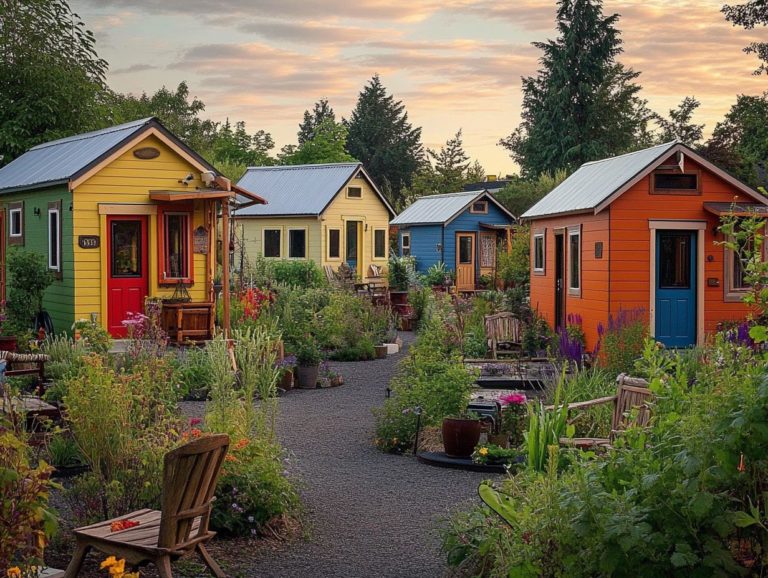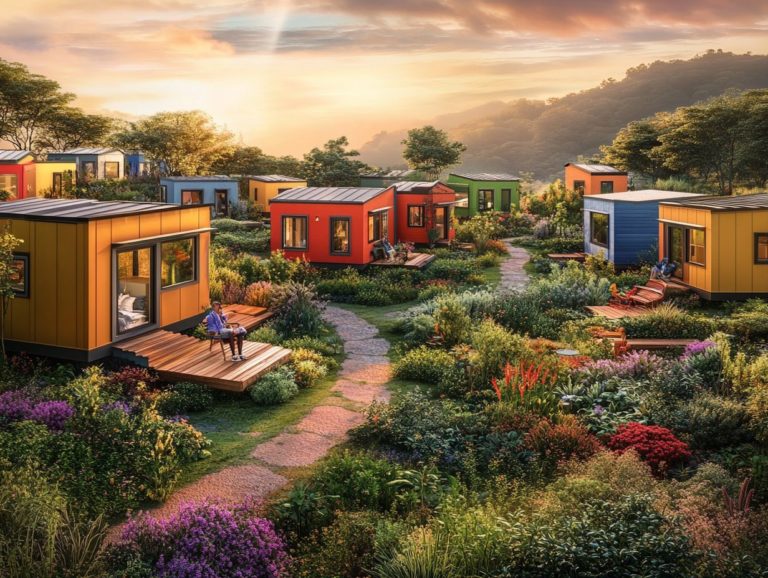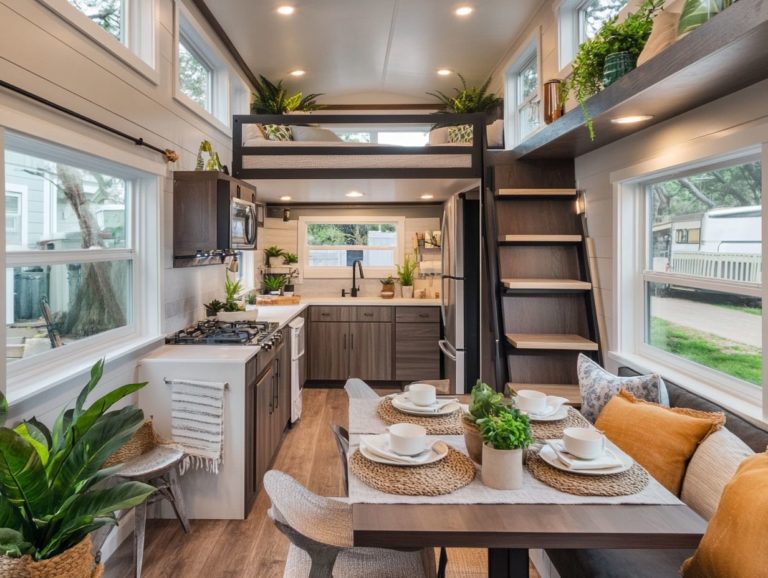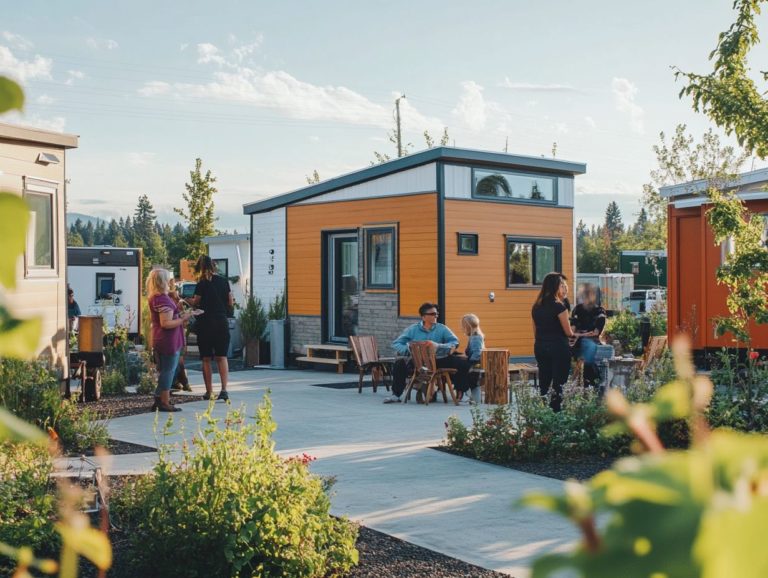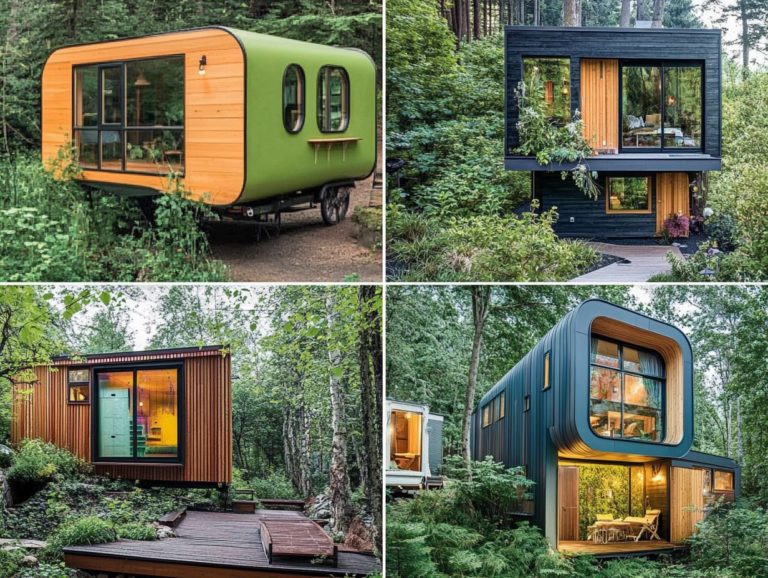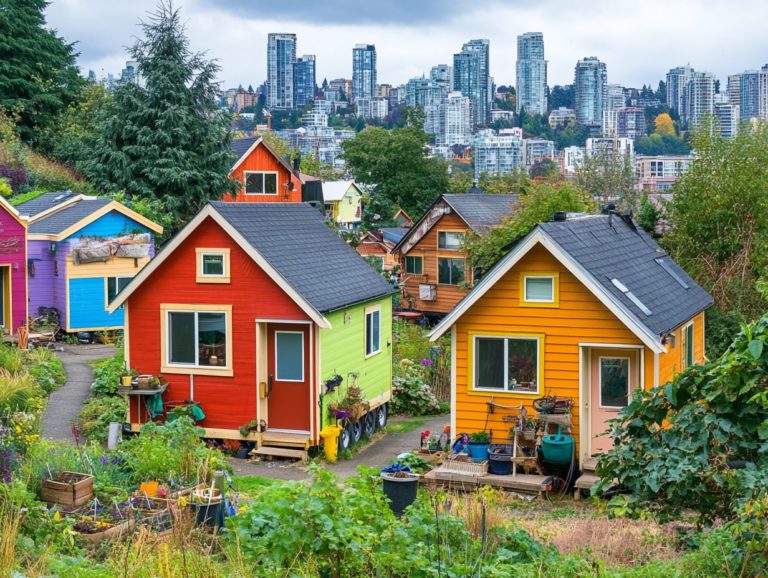Tiny House Communities: A Sustainable Living Option
The tiny house movement is rapidly gaining traction, encouraging you to reconsider your living arrangements.
Tiny house communities present not just a minimalist lifestyle, but also cultivate a genuine sense of belonging among residents.
In this discussion, you ll delve into the essence of tiny house communities, uncover their environmental and social benefits, and examine the challenges they encounter, such as legal obstacles and infrastructure concerns.
Whether you re contemplating joining an existing community or envisioning the creation of your own, this guide will equip you with the foundational knowledge you need.
Contents [hide]
Key Takeaways:
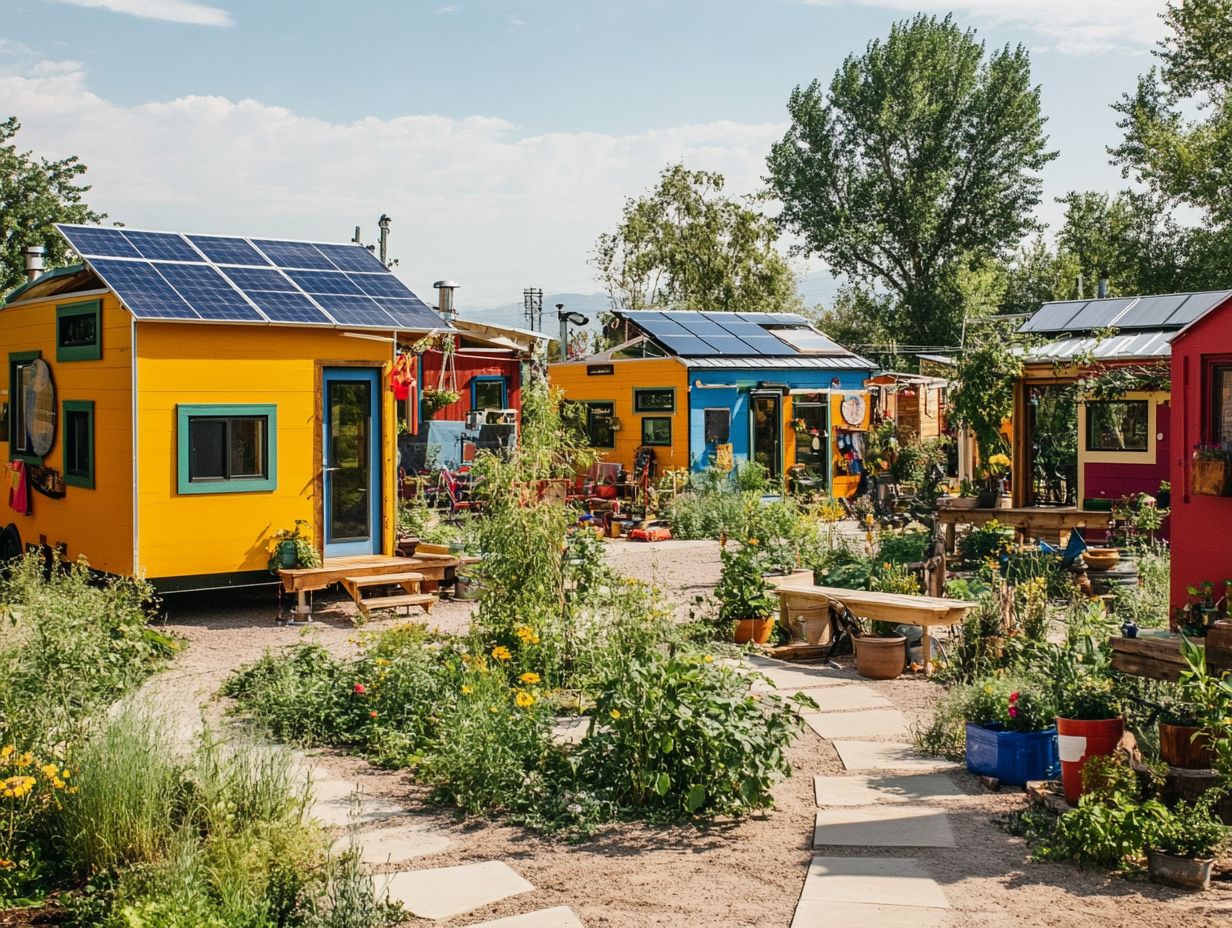
- Tiny house communities unlock exciting benefits, including environmental sustainability and a strong sense of community support.
- These communities face challenges such as legal and zoning issues, as well as infrastructure limitations, but they offer unique solutions for a simpler, more intentional way of living.
- To join or create a tiny house community, individuals should consider factors such as location, community dynamics, and legal requirements, and follow the necessary steps for a successful and fulfilling experience.
The Rise of Tiny House Communities
The emergence of tiny house communities is transforming the landscape of contemporary living, fueled by the vibrant Tiny House Movement that advocates for sustainable lifestyles and minimalism.
As homebuyers increasingly prioritize affordability and financial freedom, these communities often built with eco-friendly materials present a distinctive way of life that highlights environmental awareness and a smaller carbon footprint.
The allure of tiny living becomes even more compelling when you consider the strong sense of community that develops among tiny homeowners, fostering shared resources and enriching intentional living.
Exploring the Trend and its Benefits
Exploring the trend of tiny living reveals a lifestyle shift that emphasizes simplicity and sustainability. This movement challenges traditional housing norms and encourages you to embrace intentional living.
As you consider downsizing your living space, you might discover profound benefits, including a significantly lower environmental impact. Tiny homes typically require fewer materials for construction, translating to a smaller carbon footprint.
Homeowners often enjoy the thrill of decreased financial burdens, thanks to reduced mortgage payments and lower utility costs. In fact, studies show that tiny homeowners save around 45% on housing expenses compared to their traditional counterparts.
Many individuals report that downsizing strengthens their community ties, fostering closer relationships through shared resources and communal spaces. These lifestyle changes simplify daily routines and enhance overall well-being, making tiny living an enticing option for those of you in search of balance and fulfillment.
What is a Tiny House Community?
Imagine living in a tiny house community, where you reside in a charming, eco-friendly home that typically spans just 100 to 400 square feet. This unique arrangement fosters a deep sense of community and connection among residents.
Such communities come in various forms, from shared land developments to well-organized tiny home villages, each one highlighting customization and sustainable living practices. It s a lifestyle that nurtures relationships and promotes a harmonious existence with the environment.
Are you ready to explore the possibilities of tiny house living? Take the first step towards a simpler, more fulfilling lifestyle today!
Defining the Concept and Types of Communities
Defining tiny house communities requires you to delve into their origins within the architectural movement that champions minimalism and sustainable living. These communities come in various forms, ranging from permanent setups equipped with eco-friendly infrastructure to mobile tiny home parks, each representing unique lifestyles and values.
Some communities prioritize shared resources and communal spaces, fostering a deep sense of belonging among residents. Others emphasize the freedom of mobility, featuring park-like environments where individuals can easily relocate.
Noteworthy examples include Villart Micro Office, an innovative space that seamlessly blends work and living, and D houses, compact homes with sleek, sustainable designs that harmonize with nature.
Each of these communities brings its own set of advantages, such as lower living costs and a smaller ecological footprint. However, they also present challenges like zoning regulations and the complexities of communal decision-making.
The architectural movement behind these communities shapes their designs and philosophies today, promoting a balanced approach between individual needs and collective living.
Advantages of Living in a Tiny House Community
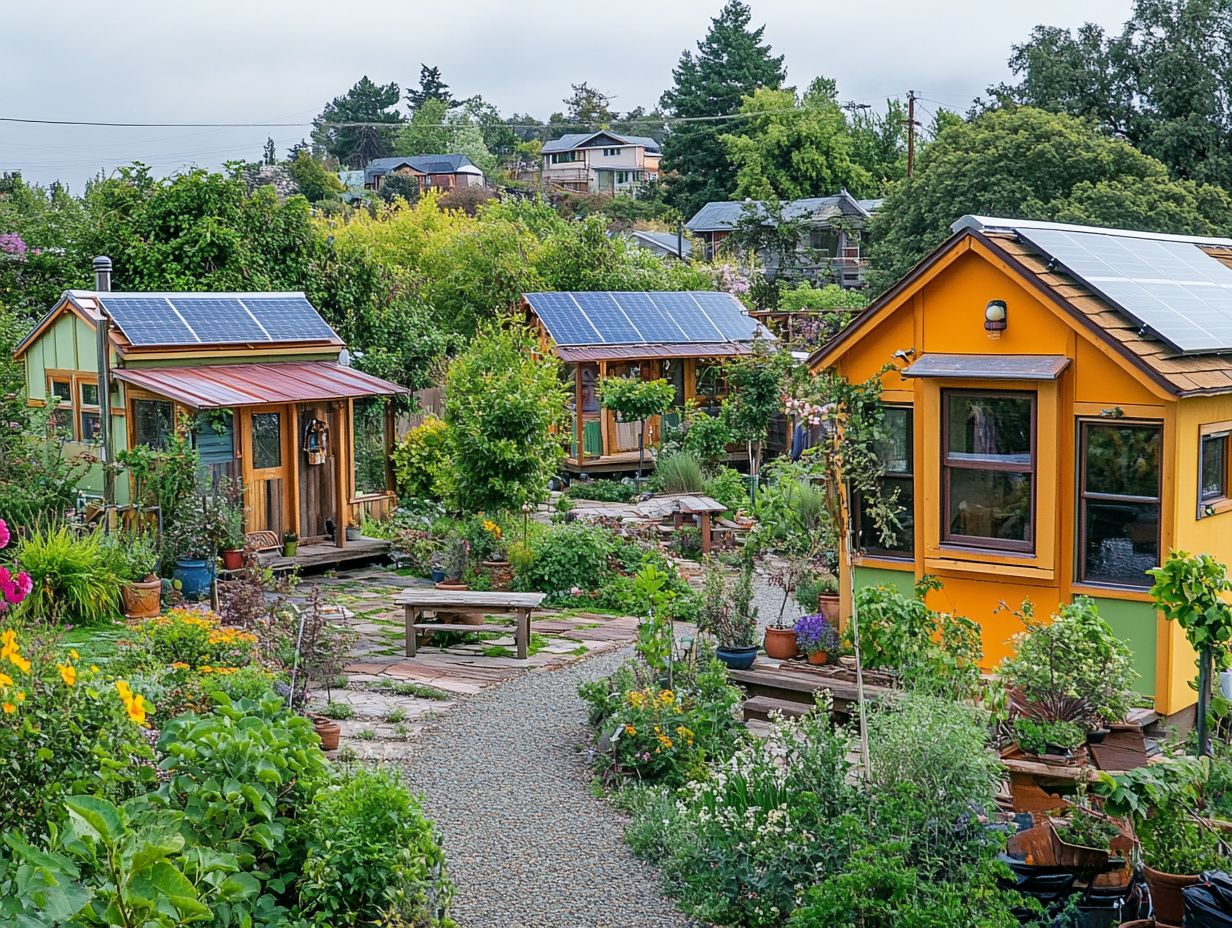
Residing in a tiny house community offers an array of benefits that elevate both your personal lifestyle and the well-being of the collective. You’ll find a profound sense of community support, a smaller environmental footprint, and an enriched quality of life, all stemming from sustainable living practices.
Environmental Sustainability
Environmental sustainability serves as the foundation of tiny house communities. Their designs prominently feature eco-friendly practices and materials that greatly minimize your carbon footprint. By embracing sustainable materials like treated wood that lasts longer and harnessing solar panels for your energy needs, these homes reflect a genuine commitment to environmental protection.
You can further enhance your sustainability efforts by adopting innovative methods such as rainwater harvesting systems. These systems allow you to reduce reliance on municipal water supplies and potentially save thousands of gallons each year. The use of composting toilets not only minimizes waste but also enriches the soil, seamlessly aligning with organic gardening practices.
Consider this: tiny homes use about 45% less energy than bigger houses, underscoring a significant shift towards sustainable living. Communities that prioritize sustainable building practices have reported waste generation reductions of up to 30%, demonstrating that eco-conscious choices can lead to meaningful environmental benefits.
Community Support and Connection
The community support and connection you find in tiny house communities are essential to the lifestyle. They encourage intentional living and collaboration among fellow tiny homeowners. In these neighborhoods, you’ll discover strong relationships that enhance social well-being and create a valuable network of support.
Individuals share not just physical space, but also experiences and resources. This fosters a profound sense of belonging. Many residents emphasize this interconnectedness, noting how it transforms their living experience from simple cohabitation into a familial environment. One homeowner remarked, “I never thought I could find a place where neighbors are friends, and we all come together for potlucks or to help each other with projects.”
This sense of community doesn t just uplift spirits; it nurtures collaboration, whether through shared gardening efforts or organizing group activities. Together, you ll create a vibrant atmosphere where everyone thrives.
Challenges of Tiny House Communities
Tiny house communities present a multitude of advantages, yet they also encounter considerable challenges that can impede their growth and sustainability.
You will need to navigate legal complexities, zoning restrictions, and infrastructure limitations hurdles that tiny homeowners face in their quest to establish and maintain these distinctive living arrangements.
Ready to embrace a sustainable lifestyle? Discover tiny house communities today!
Legal and Zoning Issues
Legal and zoning issues can create significant hurdles when trying to establish and operate tiny house communities. Often, these challenges arise from outdated regulations that don’t accommodate the unique characteristics of tiny living.
You might encounter everything from restrictive building codes to local ordinances that dictate where tiny homes can be placed.
In many regions, tiny homes are classified as recreational vehicles. This misclassification complicates their legality and use in residential zones, hindering your ability to secure necessary permits for viable living spaces.
Take California, for example. Certain cities are grappling with a surge of tiny home advocates pushing for legislative reform. These advocates urge officials to rethink how zoning laws define housing.
Community organizations are uniting to advocate for meaningful changes. They aim to create more inclusive building codes and expand the areas where tiny homes can legally reside. These grassroots efforts not only reshape local policies but also raise awareness about the benefits of tiny living, such as affordability and environmental sustainability.
Infrastructure and Resource Limitations
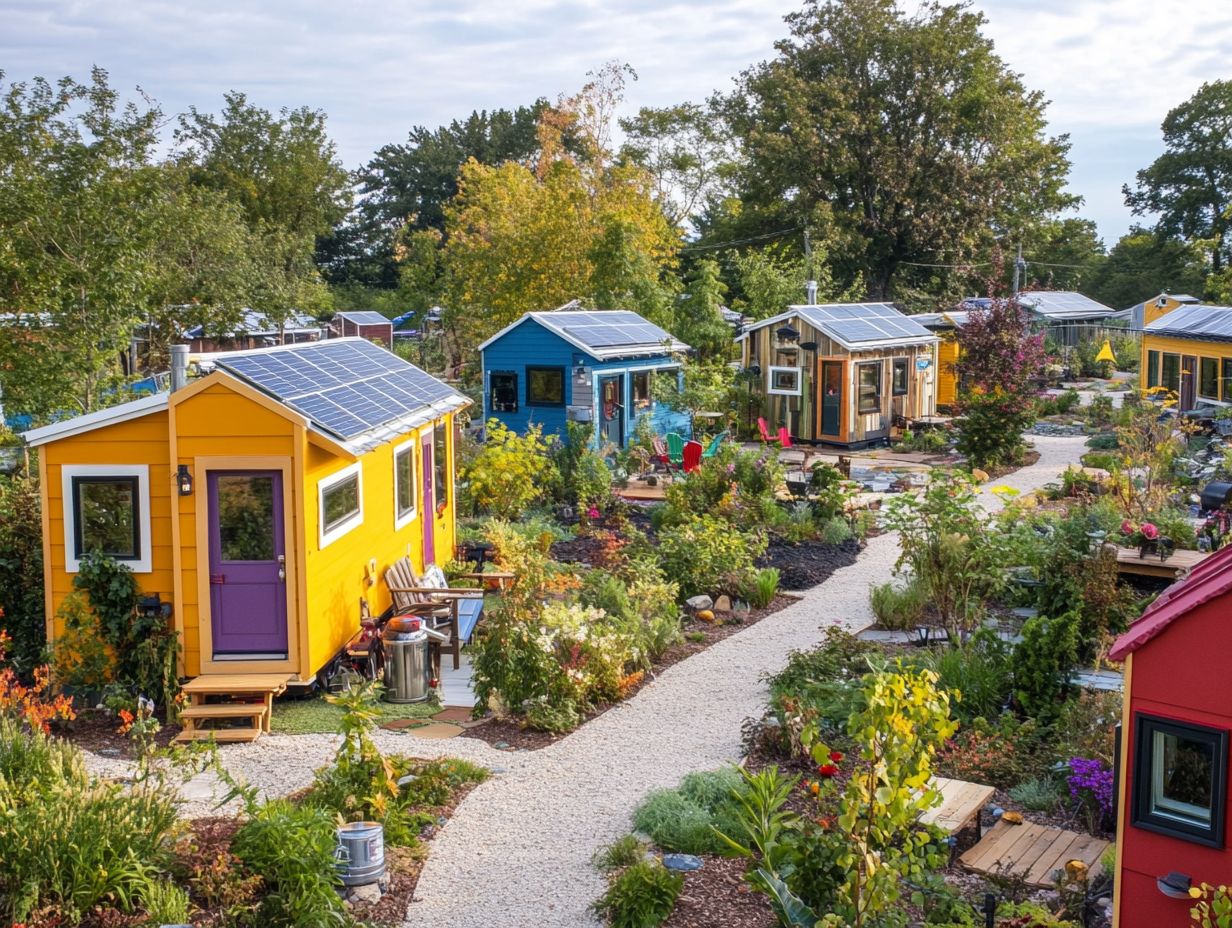
Infrastructure and resource limitations present critical challenges for many tiny house communities. These issues affect everything from waste management systems to access to essential utilities and services.
For those embracing a minimalist lifestyle, ensuring that your basic needs are met is paramount. This means having reliable sources of water, efficient electricity systems, and effective waste disposal solutions.
More communities are exploring eco-friendly alternatives, such as rainwater harvesting and solar panels. These initiatives significantly reduce reliance on municipal services. Composting toilets, which turn waste into valuable compost without using water, are also gaining traction.
By implementing these creative strategies, tiny house communities can flourish while staying committed to sustainability and autonomy.
Community Dynamics
Understanding community dynamics is crucial for success in tiny house communities. Social interactions among residents profoundly influence their overall experience.
These dynamics cultivate the culture of the community, encouraging collaboration, support, and shared values. Exploring the interplay of personalities, conflict resolution strategies, and shared responsibilities shows how these elements contribute to a harmonious living environment.
When disagreements arise, residents who prioritize open communication and empathy are more likely to reach amicable solutions. Organized community events, such as potlucks or book clubs, offer opportunities for connection and strengthen the social fabric.
These gatherings can lead to enduring friendships, fostering a sense of belonging that enhances everyday life in tiny house communities. Engaging in cooperative projects like gardening or shared maintenance builds trust and cultivates a spirit of camaraderie.
How to Join or Create a Tiny House Community
Joining or creating a tiny house community requires careful thought and a series of essential steps. These steps ensure that your leap into tiny living is an exciting adventure.
You need to familiarize yourself with local zoning laws the rules that dictate where you can build homes as these can significantly impact your plans. Building relationships with potential neighbors is equally important; forging connections helps you integrate into a supportive community where everyone shares a similar vision of minimalism and sustainable living.
Embrace this journey and navigate various aspects, knowing that the rewards of a vibrant tiny house community are well worth the effort.
Start your journey to tiny living today!
Steps and Considerations
Joining or creating a tiny house community involves careful planning and awareness of legal requirements and community dynamics. Understanding the nuances of zoning laws, financing options, and available resources can significantly impact your success.
To get started, dive into local zoning regulations. Some areas might ban tiny homes or impose specific stipulations. For instance, certain counties classify tiny homes as accessory dwelling units (ADUs), simplifying compliance if you follow established guidelines.
Regarding financing, your options can be diverse. Many individuals opt for personal loans or seek alternative lenders who specialize in tiny house financing. Engaging with the community is equally important. Hosting informational meetings or workshops can foster camaraderie and allow potential residents to address common concerns.
Success stories from places like Oregon and Texas showcase the value of forming a supportive network. This makes the transition into community living smoother, ultimately leading to a more sustainable lifestyle.
Frequently Asked Questions
What are tiny house communities?
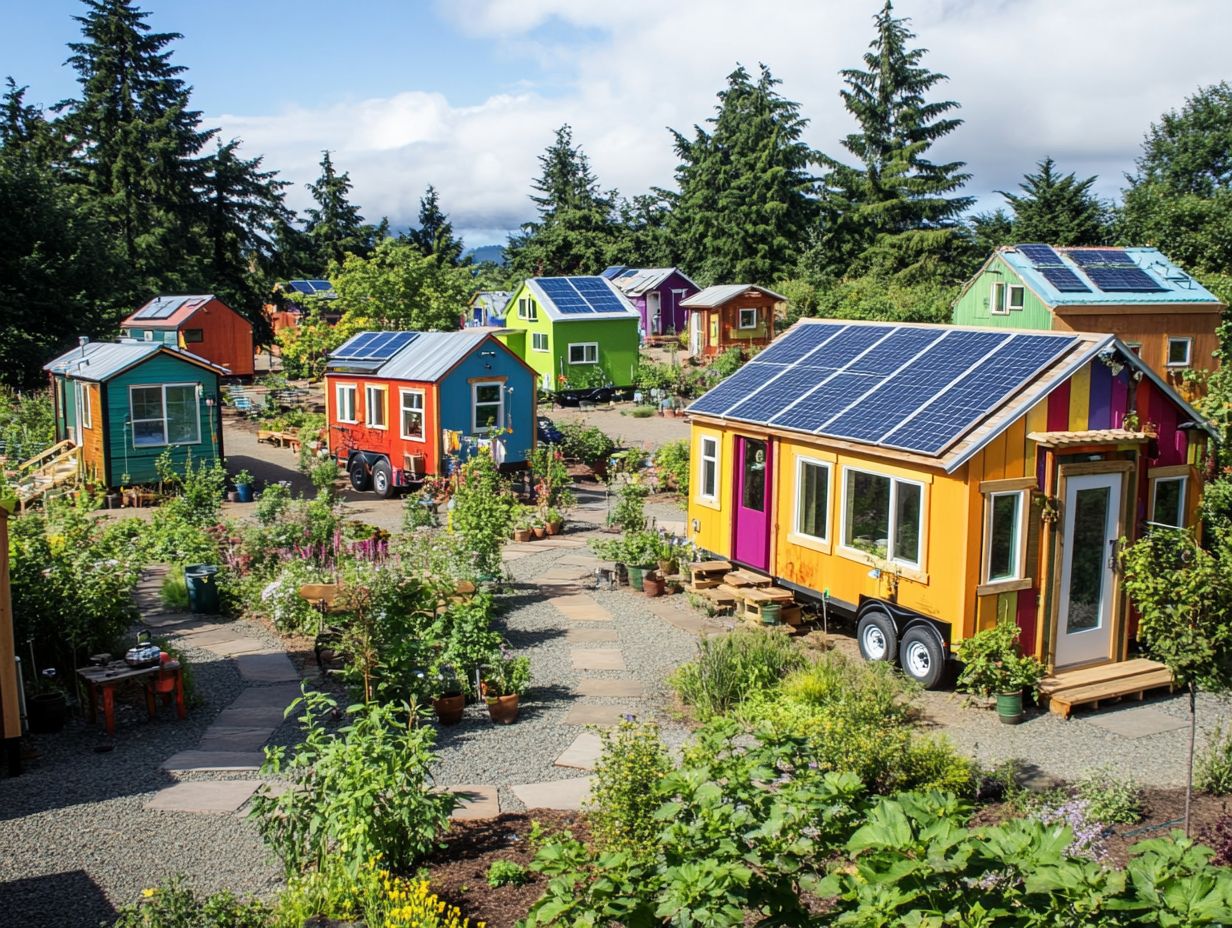
Tiny house communities are neighborhoods or developments where small, sustainable homes are clustered together with shared amenities and a focus on community living.
What makes tiny house communities a sustainable living option?
Tiny house communities promote sustainability by utilizing smaller living spaces, which require less energy and resources to build and maintain. They also encourage a communal lifestyle, reducing the need for individual resources and promoting shared resources.
Are tiny house communities legal?
The legality of tiny house communities varies depending on location. Some cities and towns have zoning regulations that allow for tiny house communities, while others may have restrictions. Researching local laws is crucial to your success!
What are the benefits of living in a tiny house community?
Living in a tiny house community allows for a simpler, more affordable lifestyle. It promotes a sense of community and connection with others, as well as a focus on sustainable living practices.
Do tiny house communities have shared amenities?
Yes, many tiny house communities include shared amenities such as communal gardens, laundry facilities, and common spaces for socializing. These shared resources promote a more sustainable and efficient use of resources.
Can anyone live in a tiny house community?
Tiny house communities are typically open to anyone interested in living a more sustainable and communal lifestyle, as long as they adhere to the community’s rules and regulations. Some communities may have age restrictions or requirements for the size and style of tiny homes.
Ready to explore tiny house living? Start your journey today!

